|

Lombardy (Italian: Lombardia Italian pronunciation: [lombarˈdiːa], Western Lombard: Lumbardìa, Eastern Lombard: Lombardia) is one of the 20 regions of Italy. The capital is Milan. One-sixth of Italy's population lives in Lombardy and about one fifth of Italy's GDP is produced in this region, making it the most populous and richest region in the country and one of the richest in the whole of Europe. Major tourist destinations in the region include the historic, cultural and artistic cities of Milan (which is Italy's second top tourist destination), Brescia, Mantua, Pavia, Como, Cremona, Bergamo, Sondrio, Lecco, Lodi, Varese, Monza, and the lakes of Garda, Como, Maggiore, and Iseo.
The official language, as in the rest of Italy, is Italian. The traditional local languages are the various dialects of Lombard (Western Lombard and Eastern Lombard), as well as some dialects of Emilian, spoken in some parts of the provinces of Mantua, Pavia, and Cremona. According to Istat, almost 27% of Lombards are bilingual with Lombard and Italian languages; 9.1% are monolingual in Lombard and 57.6% are monolingual in Italian.
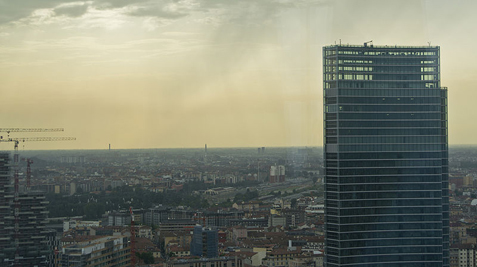
The Government Skyscraper
Etymology
The word Lombardy originally referred to the entire region composed of Northern and Central Italy, home to the Germanic tribe of the Lombards, that settled the region along with much of northern Apennine Peninsula in 6th century. This name, in turn, is derived from Middle English Lombard, from the merger of Old English Longbeard (“Lombard”); and Old French Lombard, Lombart (“a Lombard”), from Late Latin Longobardus, Langobardus (“a Lombard”), derived from the Proto-Germanic elements *langaz + *bardaz; equivalent to long + beard. Some sources derive the second element instead from Proto-Germanic *bardǭ, *barduz (“axe”), related to German Barte (“axe”).
Geography
Lombardy is bordered by Switzerland (north: Canton Ticino and Canton Graubünden) and by the Italian regions of Trentino-Alto Adige/Südtirol and Veneto (east), Emilia-Romagna (south), and Piedmont (west). Three distinct natural zones can be fairly easily distinguished in the Lombardy region: mountains, hills and plains – the latter being divided in Alta (high plains) and Bassa (low plains).
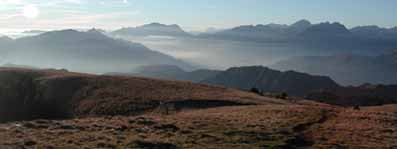 Panorama of Bergamasque Alps Panorama of Bergamasque Alps
The most important mountainous area is an Alpine zone including the Lepontine and Rhaetian Alps, (Piz Bernina – La Spedla, 4,020 m), the Bergamo Alps, the Ortler Alps and the Adamello massif; it is followed by an Alpine foothills zone Prealpi, which include the main peaks are the Grigna Group (2,410 m), Resegone (1,875 m) and Presolana (2,521 m). The great Lombard lakes, all of glacial origin lie in this zone. From west to east these are Lake Maggiore, Lake Lugano (shared with Switzerland), Lake Como, Lake Iseo, Lake Idro, then Lake Garda, the largest in Italy. South of the Alps lie the hills characterized by a succession of low heights of morainic origin, formed during the last Ice Age and small barely fertile plateaux, with typical heaths and conifer woods. A minor mountainous area lies south of the Po, in the Appennines range.
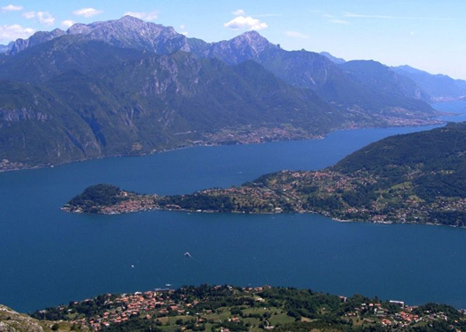
Lake Como and Bellagio
The plains of Lombardy, formed from alluvial deposits, can be divided into the Alta – an upper, permeable ground zone in the north and a lower zone characterized – the Bassa – by the so-called line of fontanili (the spring waters rising on impermeable ground). Anomalous compared with the three distinctions already made is the small region of the Oltrepò Pavese, formed by the Apennine foothills beyond the Po River. A large number of rivers, all direct or indirect tributaries of the Po, cross the plains of Lombardy. Major rivers, flowing NW to SE, are the Ticino, the outlet of Lake Maggiore, the Olona, the Lambro, the Adda, outlet of Lake Como, the Mincio, outlet of Lake Garda, and the Oglio, the Lake Iseo outflow. There is a wide network of canals for irrigation purposes. In the plains, intensively cultivated for centuries, little of the original environment remains. The rare elm, alder, sycamore, poplar, willow and hornbeam woods and heaths are covered now by several protected areas. In the area of the great Alpine foothills lakes, however, grow olive trees, cypresses and larches, as well as varieties of subtropical flora such as magnolias, azaleas, acacias, etc. The mountains area is characterized by the typical vegetation of the whole range of the Italian Alps. At a lower levels (up to approximately 1,100 m) oak woods or broadleafed trees grow; on the mountain slopes (up to 2,000–2,200 m) beech trees grow at the lowest limits, with conifer woods higher up. Shrubs such as rhododendron, dwarf pine and juniper are native to the summital zone (beyond 2,200 m).
The climate of this region is continental, though with variations depending on altitude or the presence of inland waters. The continental nature of the climate is more accentuated on the plains, with high annual temperature changes (at Milan an average January temperature is 1.5 °C (35 °F) and 24 °C (75 °F) in July), and thick fog between October and February. The Alpine foothills lakes exercise a mitigating influence, permitting the cultivation of typically Mediterranean produce (olives, citrus fruit). In the Alpine zone, the valley floor is relatively mild in contrast with the colder higher areas (Bormio, 1,225 m, −1.4 °C (29 °F) average in January, 17.3 °C (63 °F) in July). Precipitations are more frequent in the Prealpine zone (up to 1,500–2,000 mm annually) than on the plains and Alpine zones (600 mm to 850 mm annually). The numerous species of endemic flora (the Lombard native species), typical mainly of the Lake Como area, include some kinds of saxifrage, the Lombard garlic, groundsels bellflowers and the cottony bellflowers. Lombardy counts many protected areas: the most important are the Stelvio National Park (the largest Italian natural park), with typically alpine wildlife: red deer, roe-deer, ibex, chamois, foxes, ermine and also golden eagles; and the Ticino Valley Natural Park, instituted in 1974 on the Lombard side of the Ticino River to protect and conserve one of the last major examples of fluvial forest in Northern Italy.
History
Early History
The area of current Lombardy was settled at least since the 2nd millennium BC, as shown by the archaeological findings of ceramics, arrows, axes and carved stones.
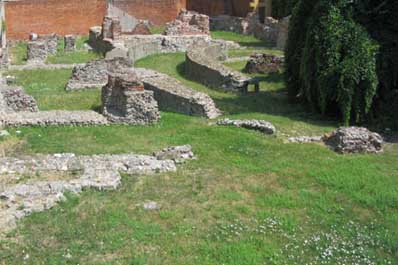 Roman ruins of the Imperial palace of Mediolanum Roman ruins of the Imperial palace of Mediolanum
In the following centuries it was inhabited by different peoples amongst whom the Etruscans, who founded the city of Mantua and spread the use of writing; later, starting from the 5th century BC, the area was invaded by Celtic – Gallic tribes. These people settled in several cities (including Milan) and extended their rule to the Adriatic Sea. Their development was halted by the Roman expansion in the Po Valley from the 3rd century BC onwards: after centuries of struggle, in 194 BC the entire area of what is now Lombardy became a Roman province with the name of Gallia Cisalpina ("Gaul on the nearer side of the Alps"). The Roman culture and language overwhelmed the former civilization in the following years, and Lombardy became one of the most developed and rich areas of Italy with the construction of a wide array of roads and the development of agriculture and trade. Important figures like Pliny the Elder (in Como) and Virgil (in Mantua) were born here. In late antiquity the strategic role of Lombardy was emphasized by the temporary moving of the capital of the Western Empire to Mediolanum (Milan). Here, in 313 AD, emperor Constantine issued the famous edict that gave freedom of confession to all religions within the Empire.

Ancient Celtic artifacts retrieved in Lombardy
Middle Ages
During and after the fall of the Western Empire, Lombardy suffered heavily from destruction brought about by a series of invasions by tribal peoples. The last and most effective was that of the Lombards, or Longobardi, who came around 570s and whose long-lasting reign (whose capital was set in Pavia) gave the current name to the region. There was a close relationship between the Frankish, Bavarian and Lombard nobility for many centuries. After the initial struggles, relationships between the Lombard people and the Latin-speaking people improved. In the end, the Lombard language and culture assimilated with the Latin culture, leaving evidence in many names, the legal code and laws among other things. The end of Lombard rule came in 774, when the Frankish king Charlemagne conquered Pavia and annexed the Kingdom of Italy (mostly northern and central Italy) to his empire. The former Lombard dukes and nobles were replaced by other German vassals, prince-bishops or marquises. The 11th century marked a significant boom in the region's economy, due to improved trading and, mostly, agricultural conditions. In a similar way to other areas of Italy, this led to a growing self-acknowledgement of the cities, whose increasing richness made them able to defy the traditional feudal supreme power, represented by the German emperors and their local legates. This process reached its apex in the 12th and 13th centuries, when different Lombard Leagues formed by allied cities of Lombardy, usually led by Milan, managed to defeat the Hohenstaufen Emperor Frederick I, at Legnano, and his grandson Frederick II, at Parma.
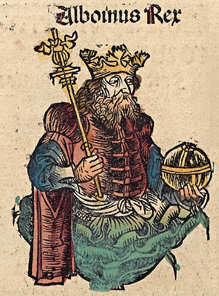
King Alboin led the Lombard migration into the Po Valley and made Pavia the capital
This did not prevent other important Lombard centres, like Cremona (then rivalling Milan for size and wealth) and others, from supporting the imperial power if this could grant them an immediate advantage. Taking advantage of the flourishing agriculture, the area around the Po River, together with Venice and Tuscany, continued to expand its industry and commerce until it became the economic centre of the whole of Europe. The enterprising class of the communes extended its trade and banking activities well into northern Europe: "Lombard" designated the merchant or banker coming from northern Italy (see, for instance, Lombard Street in London). The name "Lombardy" came to designate the whole of Northern Italy until the 15th century and sometimes later. From the 14th century onwards, the instability created by the unceasing internal and external struggles ended in the creation of noble seignories, the most significant of which were those of the Viscontis (later Sforzas) in Milan and of the Gonzagas in Mantua. In the 15th century the Duchy of Milan was a major political, economical and military force at the European level. Milan and Mantua became two centres of the Renaissance whose culture, with men like Leonardo da Vinci and Mantegna, and pieces of art were highly regarded (for example, Leonardo da Vinci's The Last Supper). This richness, however, attracted the now more organized armies of national powers like France and Austria, which waged a lengthy battle for Lombardy in the late 15th-early 16th century.
Modern Era
After the decisive Battle of Pavia, the Duchy of Milan became a possession of the Habsburgs of Spain: the new rulers did little to improve the economy of Lombardy, instead imposing a growing series of taxes needed to support their unending series of European wars. The eastern part of modern Lombardy, with cities like Bergamo and Brescia, was under the Republic of Venice, which had begun to extend its influence in the area from the 14th century onwards (see also Italian Wars). Pestilences (like that of 1628/1630, described by Alessandro Manzoni in his I Promessi Sposi) and the generally declining conditions of Italy's economy in the 17th and 18th centuries halted the further development of Lombardy. In 1706 the Austrians came to power and introduced some economical and social measures which granted a certain recovery. Their rule was smashed in the late 18th century by the French armies, however, and with the formation of the Napoleonic Empire, Lombardy became one of the semi-independent provinces of Napoleonic France. The restoration of Austrian rule in 1815, in the form of the puppet state called Kingdom of Lombardy–Venetia, had however to contend with new social ideals introduced by the Napoleonic era. Lombardy became one of the intellectual centres leading to Italian unification. The popular republic of 1848 was short-lived, its suppression leading to renewed Austrian rule. This came to a decisive end when Lombardy was annexed to the Kingdom of Italy 1859 as a result of the Second Italian Independence War. When annexed to the Kingdom of Italy in 1859 Lombardy achieved its present-day territorial shape by adding the Oltrepò Pavese (formerly the southern part of Novara's Province) to the province of Pavia. Starting from the late 19th century, and with a boom after World War II, Lombardy sharpened its status of richest and most industrialized region of Italy.
Demographics
One sixth of the Italian population or about 10 million people live in Lombardy (16.2% of the national population; 2% of the European Union population), making it the second most densely populated region in Italy after Campania with a strong concentration in the Milan metropolitan area and the Alpine foothills areas of the provinces of Varese, Como, Lecco, Monza and Brianza and Bergamo, (1,200 inh./km2), a lower average density (250 inh./km2) in the Po valley and the lower Brescia valleys, and much lower densities (less than 60 inh./km2) in the northern mountain areas and the southern Oltrepò Pavese subregion.
Historical Population |
Year |
Population |
Percent Change |
1861 |
3,160,000 |
- - - - - |
1871 |
3,529,000 |
+11.7% |
1881 |
3,730,000 |
+5.7% |
1901 |
4,314,000 |
+15.7% |
1911 |
4,889,000 |
+13.3% |
1921 |
5,186,000 |
+6.1% |
1931 |
5,596,000 |
+7.9% |
1936 |
5,836,000 |
+4.3% |
1951 |
6,566,000 |
+12.5% |
1961 |
7,406,000 |
+12.8% |
1971 |
8,543,000 |
+15.4% |
1981 |
8,892,000 |
+4.1% |
1991 |
8,856,000 |
−0.4% |
2001 |
9,033,000 |
+2.0% |
2011 |
9,939,000 |
+10.0% |
| Source: ISTAT 2001 |
The growth of the regional population was particularly sustained during the 1950s–60s, thanks to a prolonged economic boom, high birth rates, and strong immigration flows (especially from Southern Italy). During the last two decades, Lombardy became the destination of a large number of international immigrants, insomuch that today more than a quarter of all foreign immigrants in Italy lives in this region. As of 2008, the Italian national institute of statistics ISTAT estimated that 815,335 foreign-born immigrants live in Lombardy, equal to 8.4% of the total regional population.
Economy
The gross domestic product in Lombardia (equal to over €318.424 billion in 2009) accounts for 20% of the total gross domestic product of Italy. When this measure is considered by inhabitant, it results in a value of €31,600 per inhabitant, which is almost 25% higher than the national average of €24,300.
Government and Politics
The politics of Lombardy take place in a framework of a presidential representative democracy, whereby the President of the Region (Presidente della Regione) is the head of government, and of a pluriform multi-party system. Executive power is exercised by the Regional Government (Giunta Regionale). Legislative power is vested in the Regional Council (Consiglio Regionale).
Administrative Divisions
Lombardy is divided into 12 provinces:
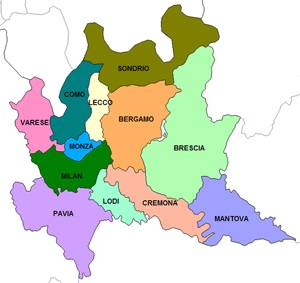
Province |
Area (km²) |
Population |
Density (inh./km²) |
| Province of Bergamo |
2,723 |
1,070,060 |
392.9 |
| Province of Brescia |
4,784 |
1,223,900 |
255.8 |
| Province of Como |
1,288 |
582,736 |
452.4 |
| Province of Cremona |
1,772 |
358,628 |
202.4 |
| Province of Lecco |
816 |
334,059 |
409.4 |
| Province of Lodi |
782 |
222,223 |
284.2 |
| Province of Mantova |
2,339 |
407,983 |
174.4 |
| Province of Milan |
1,575 |
3,121,832 |
1,982 |
| Province of Monza and Brianza |
405 |
840,711 |
2,075 |
| Province of Pavia |
2,965 |
535,948 |
535,948 |
| Province of Sondrio |
3,212 |
181,841 |
56.6 |
| Province of Varese |
1,199 |
868,777 |
724.6 |
Culture
Although Lombardy as a region is often identified as merely an economic and industrial powerhouse, it has interesting examples even from the standpoint of cultural and artistic. The many examples range from prehistory to the present day, through the Roman period and the Renaissance and can be found both in museums and churches that enrich cities and towns around the region.
UNESCO World Heritage Sites
Photos of Lombardy

 ITALY-SCHOOLS - Italian Website Portal
Phone: +39 0836 805350 - Mobile: +39 329 2956361
www.italy-schools.com - info@italy-schools.com |
|